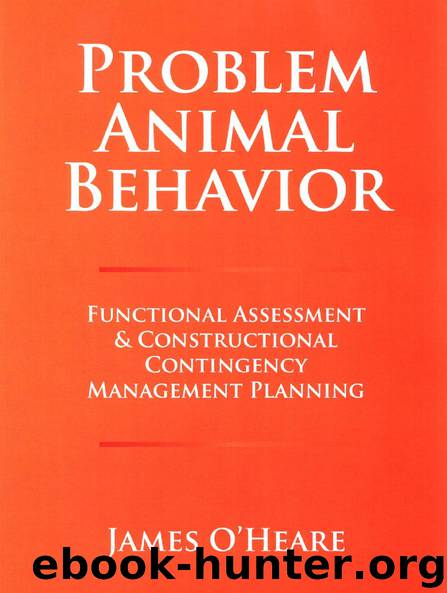Problem Animal Behavior by James O’Heare

Author:James O’Heare
Language: eng
Format: epub
Publisher: Dogwise Publishing
Published: 2016-08-27T00:00:00+00:00
Screening
Conducting a functional assessment and intervention is an effort-, time-, and money-intensive project and the initial contact with the client or potential client should establish the need for your participation and expenditure of the client’s effort, time, and money. Have the client describe the problem and follow up with questions until you have a reasonable functional picture of the nature and scope of the problem as they view it.
Determine whether an intervention is appropriate at all. Some problems may be so minor and/or have quick easy solutions, that a full proper functional assessment and intervention may not be required. For example, if a dog digs their way out of the yard under a fence, you might suggest lining the area with patio pavers and/or outside supervision. If this seems reasonable to the client, then that may be all that is required. Of course, circumstances are not always as clients describe and caution must be taken when providing casual advice without a proper functional assessment, but sometimes the problem is minor and obvious (to a professional) and the solution equally as obvious. If you make such recommendations, it is a good idea to explain what it should achieve and that if there is some problem with it, they ought to get back in touch with you to proceed to find a supervised solution.
Determine whether you have the appropriate competencies in the specific kind of problem that the potential client is bringing to you. If you are not comfortable handling the case, it is best to provide the client with contact information for someone that is or to guide them to a professional association or certifying body that can assist them in finding someone suited to the case. In some cases, you might be able to take a case that is just on the edge of your comfort zone in this respect by securing formal supervision through the case, or assisting/observing in some manner in the case along with the technologist that you refer the case to in order to increase your own competencies.
Determine the risks associated with the problem behavior. Ideally, you want to begin by establishing a baseline for the level of the behavior quantitatively, which involves allowing the behavior to occur. Does the problem behavior pose a risk to them, the client, or anyone else? Can the risk be mitigated and still allow the behavior to occur as usual? If there is a risk and it cannot be mitigated, provide advice on preclusion—controlling the subject’s antecedent environment such that the behavior cannot occur. These practices will remain in effect through the functional assessment process. If the behavior does not pose a safety risk and the nature of the behavior is reasonably clear, you may establish a tentative target behavior definition and have the client track the rate, relative frequency, and/or duration of the problem until you can meet to begin the functional assessment interview. Prepare for them or describe over the phone how they may prepare a simple chart that will help them keep track of the behaviors.
Download
This site does not store any files on its server. We only index and link to content provided by other sites. Please contact the content providers to delete copyright contents if any and email us, we'll remove relevant links or contents immediately.
Finding Gobi by Dion Leonard(2779)
Grumpy Cat by Grumpy Cat(2683)
A New Earth: Awakening to Your Life's Purpose by Eckhart Tolle(2595)
The Silkworm by Robert Galbraith(2442)
Tippi by Tippi Hedren(2181)
End of Days by Sylvia Browne(2114)
Total Cat Mojo by Jackson Galaxy(1967)
Backyard Chickens Beyond the Basics by Pam Freeman(1904)
The Animals Among Us by John Bradshaw(1830)
The Ultimate Pet Health Guide by Gary Richter(1726)
All Things Bright and Beautiful by James Herriot(1707)
Vet in Harness by James Herriot(1663)
Doggy Desserts: 125 Homemade Treats for Happy, Healthy Dogs by Cheryl Gianfrancesco(1652)
Dog Years by Mark Doty(1642)
Cesar's Way by Cesar Millan(1632)
Chicken Soup for the Ocean Lover's Soul by Jack Canfield(1600)
Dog Training 101 by Kyra Sundance(1556)
Walking with Peety by Eric O'Grey(1553)
Animal Speak by Ted Andrews(1513)
